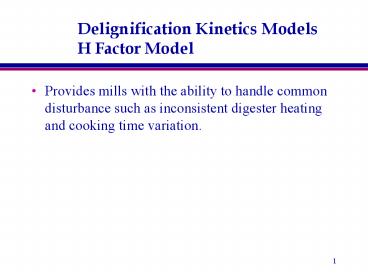Delignification Kinetics Models H Factor Model - PowerPoint PPT Presentation
1 / 29
Title:
Delignification Kinetics Models H Factor Model
Description:
Delignification Kinetics Models. H Factor Model ... UW model. Divide lignin into 3 phases, each with their own kinetics. 1 lignin, 3 kinetics ... – PowerPoint PPT presentation
Number of Views:484
Avg rating:3.0/5.0
Title: Delignification Kinetics Models H Factor Model
1
Delignification Kinetics ModelsH Factor Model
- Provides mills with the ability to handle common
disturbance such as inconsistent digester heating
and cooking time variation.
2
Delignification Kinetics ModelsH
Factor/Temperature
3
Delignification Kinetics ModelsH Factor Model
Relative reaction rate
- k0 is such that H(1 hr, 373K) 1
4
Delignification Kinetics ModelsH Factor Model
- Uses only bulk delignification kinetics
k Function of HS- and OH-
R
T K
5
Kraft Pulping KineticsH Factor/Temperature
6
Empirical Kraft Pulping Models
- Models developed by regression of pulping study
results - Excellent for digester operators to have for
quick reference on relation between kappa and
operating conditions - Hatton models are excellent examples of these
7
Emperical Kraft Pulping Models
Hatton Equation
Kappa (or yield) ?-?(log(H)EAn) ?,?, and n
are parameters that must be fit to the data.
Values of ?,?, and n for kappa prediction are
shown in the table below.
Warning These are empirical equations and apply
only over the specified kappa range.
Extrapolation out of this range is dangerous!
8
Delignification Kinetics ModelsKerr model 1970
- H factor to handle temperature
- 1st order in OH-
- Bulk delignification kinetics w/out HS-
dependence
9
Delignification Kinetics ModelsKerr model 1970
- Integrated form
H-Factor
Functional relationship between L and OH-
10
Delignification Kinetics ModelsKerr model 1970
Slopes of lines are not a function of EA charge
11
Delignification Kinetics ModelsKerr model 1970
Model can handle effect of main disturbances on
pulping kinetics
- Variations in temperature profile
- Steam demand
- Digester scheduling
- Reaction exotherms
- Variations in alkali concentration
- White liquor variability
- Differential consumption of alkali in initial
delignification - Often caused by use of older, degraded chips
- Good kinetic model for control
12
Delignification Kinetics ModelsUW model
- Divide lignin into 3 phases, each with their own
kinetics - 1 lignin, 3 kinetics
- Transition from one kinetics to another at a
given lignin content that is set by the user.
For softwood Initial to bulk 22.5 on
wood Bulk to residual 2.2 on wood
13
Delignification Kinetics ModelsUW model
- Initial
- dL/dt k1L
- E 9,500 cal/mole
- Bulk
- dL/dt (k2OH- k3OH-0.5HS-0.4)L
- E 30,000 cal/mole
- Residual
- dL/dt k4OH-0.7L
- E 21,000 cal/mole
14
Model PerformanceUW model
Pulping data for thin chips Gullichsens data
15
Model PerformanceUW model
Pulping data for mill chips - Gullichsens data
16
Model PerformanceUW model
Virkola data on mill chips
17
Model Performance (Andersson)UW Model
Model works well until very low lignin content
18
Carbohydrate Loss Models
- Modeling yield prediction A Very Difficult
Modeling Problem
19
UW Model
- Two methods have been tested, but since both have
the same accuracy, the simplest has been retained.
20
UW Model I
Basic Structure dc/dtkdL/dt
Some physical justification for this is given by
carbohydrate-lignin linkages. Carbohydrates
lumped into a single group.
21
Gustafson Model I
- Carbohydrate/lignin relation is assumed to be
stable and not a strong function of pulping
conditions. - Selectivity of reactions assumed to be slightly
dependent on OH- but independent of temperature. - Yield/kappa relationship can be improved by using
both lower pulping temperature and less alkali.
22
Model PerformanceUW model
Virkola data on mill chips
23
Prediction of pulp viscosity
- Dependence of viscosity on pulping conditions was
modeled - Viscosity is a measure of degradation of
cellulose chains - Effect of temperature, alkalinity, initial DP,
and time on viscosity is modeled - Model is compared with experimental data from two
sources
24
Prediction of pulp viscosity
25
Gullichsens viscosity data
26
Virkolas viscosity data
27
Virkolas viscosity data
28
OH- HS- Predictions
- Calculated by stoichiometry in all models as
follows
29
Model PerformanceUW model
Gullichsen data on mill chips































